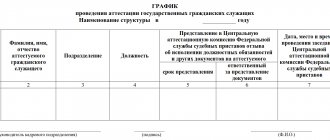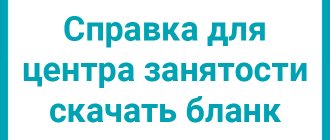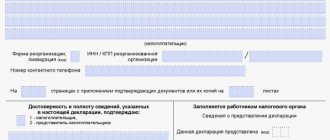Assessment of working conditions and certification of workplaces
It is immediately worth noting that at present the concept of “job certification” is not used in legislative acts; it was replaced by “special assessment of working conditions” as early as 01/01/2014. But in everyday life the phrase “worker certification” is still more often used places."
At their core, these two concepts are identical, and one and the other imply the implementation of a special set of measures aimed at identifying harmful and dangerous factors in a particular workplace.
Currently, the current law on workplace certification is the Federal Law “On Special Assessment of Working Conditions” dated December 28, 2013 No. 426-FZ (hereinafter referred to as the Law).
How often to conduct certification
For the first time, certification should be carried out immediately after the newly created company or newly registered individual entrepreneur organizes workplaces for employees. Also, “primary” certification is needed in the case when new production facilities or equipment have been commissioned, or new technologies have been introduced that affect the performance of the labor process. Finally, “initial” certification is necessary if the company has moved to a new office or occupied new premises in the previous office.
Repeated certification is carried out at workplaces where, based on the results of the previous certification, harmful or dangerous working conditions were identified. If the “initial” certification has established that working conditions at the workplace are safe, optimal or acceptable, then in general there is no need to re-certify this workplace.
In addition, re-certification is necessary if production factors and work require a mandatory medical examination of workers (the list of such factors and work was approved by order of the Ministry of Health and Social Development of Russia dated April 12, 2011 No. 302n).
Re-certification should be carried out no later than five years after the previous one.
Workplace certification: validity period
The frequency of workplace certification is as follows:
- Scheduled special assessment once every 5 years.
- Unscheduled implementation as the need arises.
Unscheduled certification of workplaces can be carried out in the following cases:
- emergence of new jobs,
- accident or occupational illness due to exposure to hazardous factors,
- changes that have occurred in the technological process,
- order of State Labor Inspectorate inspectors or at the proposal of a representative body of workers.
For such situations, Article 17 of the Law sets a deadline of 6 to 12 months for conducting an unscheduled special assessment, depending on the reason that led to it.
Another question that arises for employers who carried out workplace certification before the Law came into force: for how many years is such a check valid, is it necessary to conduct a special assessment instead? The law states that if there are no prerequisites for an unscheduled assessment, the certification will be valid for 5 years. That is, if enterprises completed it before the end of 2013, they need to conduct a special assessment for the first time only in 2020.
Frequency
As in the case of SOUT, the frequency of certification of workplaces for working conditions was 5 years.
The provisions of paragraph 4 of Article 27 of Federal Law No. 426-FZ stipulate that if an organization carried out an automated work procedure before the said Federal Law came into force, SOUT is allowed not to be carried out for five years from the date of completion of the automated work. But if circumstances arise that require an unscheduled special assessment, a special assessment will have to be carried out without waiting for the end of the planned period.
How often workplace certification or SOUT is carried out is decided by the employer: at least annually. But at least once every 5 years and every time conditions arise that oblige the employer to conduct an unscheduled special assessment.
The grounds for carrying out an unscheduled emergency assessment remain the same as for the automated workplace, with the exception of a new independent circumstance in the form of an industrial accident. The full list of grounds for an unscheduled SOUT is specified in Article 17 of Federal Law No. 426-FZ.
Certification of workplaces: who carries out
According to Article 8 of the Law, a special assessment of jobs is organized by the employer with the participation of a company that has the right to carry out such work.
There are a number of requirements for the involved organization:
- The list of activities must contain the OKPD code for workplace certification: 71.20.19.130 (according to the OKD 034-2014 classifier).
- The company must employ at least 5 certified experts.
- The company structure must include a special accredited laboratory for carrying out measurements and samples.
In order to be sure that the company entrusted with carrying out the inspection meets the stated requirements, you need to check its presence in a special list, which is located on ]]>the website of the Ministry of Labor]]>.
Price
In 2020, the cost of workplace certification (JWC) is still determined by several parameters:
- The price of the contract with the organization that directly carries out the SOUT. The price usually includes:
- cost of research and measurements;
- use of special equipment;
- travel allowances for third-party specialists, etc.
- The amount of costs based on the results of certification and rationalization of workplaces:
- if classes of hazard and danger are established, additional contributions to the Pension Fund, bonuses and compensation for workers will be required;
- acquisition of new or modernization of existing means of collective and individual protection;
- replacement of production equipment, optimization of its arrangement, etc.
- Fines for lack of certification of workplaces or untimely implementation of special assessment work (the results of the automated workplace can be challenged and found to be untrue). When choosing an organization, pay attention to its statutory documents (OKPD2 code for certification of workplaces - 71.20.19.130); information about it is necessarily present in the register of organizations conducting SOUT.
The regional factor also affects the cost of certification of workplaces based on working conditions: prices in Moscow and Syktyvkar are different.
How workplace certification is carried out
The procedure for certification of workplaces according to working conditions involves the following activities:
- Issuance of an order for certification, which appoints a commission and deadlines.
- A list of jobs subject to special assessment is determined. Here you need to take into account the frequency of workplace certification. Only those places whose previous assessment period has expired are checked.
- Direct work is being carried out to study documentation, take measurements and take samples.
- A report is drawn up, which includes a certification card and a summary statement. They include all the activities carried out and make a conclusion about the safety of the workplace and assign a certain class.
It is necessary to familiarize interested employees with the results of the special assessment.
Start of certification
To begin certification, the employer must take the following actions: firstly, create a certification commission, and secondly, enter into a civil agreement with the certifying organization.
The certification commission includes representatives of the employer, the certifying organization, trade unionists (if the company has a primary trade union organization), as well as a full-time or third-party labor protection specialist. The commission should be headed by a representative of the employer.
A certifying organization is a legal entity accredited to provide certification services. A list of such organizations can be found in your labor inspectorate. The main thing is that the certifying organization chosen by the employer is an independent person in relation to him.
Please note: you cannot conduct certification on your own, that is, without the participation of the certifying organization. It is also not allowed to involve any company of the employer’s choice instead of an accredited certification organization. This is indicated in the ruling of the appeal board of the Supreme Court of the Russian Federation dated March 28, 2013 No. APL13-103 (see “The Supreme Court refused to invalidate the existing procedure for certifying workplaces”).
After signing the contract for the provision of services, the certification organization will request a list of documents. Among them are the order to create a certification commission, a list of jobs; a list of professions and positions for which workers receive compensation for work in difficult, harmful or dangerous conditions; photocopies of technical inspection certificates; safety instructions; log of induction training, etc. As soon as the papers are prepared, specialists from the certification organization will arrive on site and begin certification.
How to pay for certification and return part of the funds spent on it
As a rule, the question of cost accounting arises among budgetary organizations that pay for the certification of workplaces. KOSGU (Classification of public sector operations) in this case refers to Article 220 “Payment for work and services” (Order of the Ministry of Finance dated July 1, 2013 No. 65n).
Another question is how can workplace certification be partially compensated? The Social Insurance Fund allows you to pay for it from contributions for “injuries”. To do this, you need to submit the appropriate package of documents to the Fund. You can receive funds both for work already carried out and for planned work. The main condition is the absence of debt on insurance premiums.
Certification of workplaces for working conditions includes a set of procedures, measurements and calculations that make it possible to determine how safe a particular workplace is. This procedure must be carried out by all employers at certain intervals. The established deadlines for workplace certification are regulated by Law No. 426-FZ (On conducting special assessments). Its types are divided into planned and unplanned.
Rights and obligations of participants in labor relations during a special assessment of working conditions
The employer has the right:
- organize a special assessment outside the plan;
- contact the company conducting the SOUT with a request to provide documents on its compliance with the established criteria, as well as to justify the results of the procedure;
- apply for an appeal against the actions of the company executing the SOUT.
The main responsibilities of the employer:
- providing conditions for the implementation of SOUT;
- preparation and transfer of requested documentation to the organization conducting the special assessment;
- familiarizing the employee with the final results in writing;
- carrying out explanatory work with the workforce on SAW issues;
- improvement of working conditions.
The employee has the right to personally take part in the process of special assessment of working conditions, request clarification from the employer regarding the course of this procedure, and also apply to appeal its results.
It is the employee’s responsibility to familiarize himself with the results of the SOUT.
Certification of workplaces: explanations of declaration
A special assessment of workplaces and working conditions is a single set of consistently implemented measures to identify harmful and (or) dangerous factors in the working environment and the labor process and assess the level of their impact on the employee, taking into account the deviation of their actual values from established standards and the use of personal and collective protective equipment for workers . (426-FZ, Article 3, clause 1).
The identification of potentially harmful and (or) dangerous production factors means the comparison and establishment of a coincidence of the factors of the production environment and labor process existing in the workplace with the factors of the production environment and the labor process provided for by the classifier of harmful and (or) dangerous production factors of labor. (426-FZ, Article 10, clause 1).
Comparison and establishment of the coincidence of the factors of the production environment and the labor process existing in the workplace with the factors of the production environment and the labor process provided for by the classifier is carried out by comparing their names (Order No. 33n, Section 2, clause 5).
The factors of the working environment and labor process present in the workplace are recognized as identified harmful and (or) dangerous factors if their names coincide with the names of the factors of the working environment and labor process provided for by the classifier. (Order No. 33n, Section 2, clause 6)
In relation to workplaces where harmful and (or) hazardous production factors have not been identified as a result of identification, the employer submits a declaration of compliance of the workplace with working conditions and state regulatory labor protection requirements. (426-FZ, Article 11, clause 1).
A special assessment of the compliance of workplaces with working conditions in accordance with state regulatory requirements for labor protection can be carried out by independent organizations that have the necessary measuring equipment and certified experts.
How to prepare for a special assessment of working conditions
Let us repeat that all conditions are spelled out and approved by Federal Law No. 426. He proposes a specific operation scheme for assessing working conditions. An organization that intends to receive documentary evidence must go through all the procedures of the preparatory stage, including: - creating a commission to organize certification: it may include the management of the company, a trade union representative or other intermediaries of associations representing the interests of employees. The presence of a medical worker and an occupational safety specialist on the commission is not discussed - it is mandatory. The lists are supported by an organization order; - a list of workplaces subject to certification is formed: the composition must contain at least 20% of similar workplaces - this is a legal requirement; — an official invitation to independent appraisers who will assess working conditions. They are not indicated on the commission's lists and act as disinterested representatives.
How to choose independent appraisers
So, to carry out the SOUT procedure, as we found out, it is necessary not only a commission approved by the organization, but also appraisers (independent representatives of the appraisal). Their choice is important, and therefore we recommend that you take a responsible approach to their composition.
The main requirements for enterprises that have the right to conduct a special assessment of working conditions: - an accreditation certificate allowing for inspection of workplaces was issued before the law on special assessment of working conditions was issued and remained valid until 2020; — presence of the laboratory in the register of appraisers, compiled by the Ministry of Labor. The issuance of certificates of conformity must be carried out by laboratories that have confirmed accreditation. Otherwise, the test results may be canceled and the procedure is repeated; — it is mandatory to have 5 or more certified employees who can conduct a special assessment; the team must include an expert with a higher education as a doctor in sanitary and hygienic inspections, occupational or general hygiene.
As soon as the contractor is selected, a contract is concluded in free form. The main legislative requirements for it are competently and clearly defined rights and obligations of the contracting parties. The document must also reflect data on the price of the services provided, and describe in detail the measures in case of poor-quality inspection and non-compliance with the general rules and clauses of the contract.
Report on the results of the inspection: report generation, signing
Confirmation of the implementation of special assessment work, as well as evidence of the provision of information about the results of the work, is an official report compiled by the appraiser. The form of the report is determined by Order of the Ministry of Labor 33n. The requirements presented in it must be strictly observed.
What data must the document comply with?
— information about the organization where the procedure was issued; — detailed information about the appraiser; — a list of jobs for which the inspection was carried out; — systematic division of working conditions based on the results of the assessment.
A document with a list of recommended measures to improve working conditions is attached to the report. There are no special requirements for its design, as a result of which it can be compiled in free form.
Rules for submitting a report on the assessment of working conditions to the main regulatory authorities
A special feature of the SOUT procedure is the need to transfer officially documented results to the State Labor Inspectorate. Moreover, this must be done independently by the controlled organization, and more specifically, by independent appraisers. According to the laws, they are responsible for solving problems related to documentary and paper formalities. It is these nuances that determine the distribution of responsibility: in the event of a timely appointment and conduct of an inspection in a company, but the report is not submitted on time, sanctions will be provided not against the employer, but against the appraiser.
Employees of the enterprise must be familiarized with the results of the SOUT
The review procedure must take place within a month (30 calendar days) after receiving the results. Law 426-FZ speaks about this. Such deadlines are set so that the director of the company has time to convey to the employees the results of the audit. The reporting period does not include weekends, planned vacations, extraordinary days off, rest between shifts, time spent working on a business trip, or sick leave.
Why do you need to communicate the received data to the staff? Work associated with hazardous working conditions, according to the law, gives employees the legal right to certain benefits, including: - reduction of the working day to 36 hours based on working hours per week (6-hour working day); — employees in this category can count on an increase in salary (~4%).
The format for presenting SOUT results is an introductory sheet. The data is submitted in free form, the main condition is the reliability of the information.
Carrying out SOUT: preparing and submitting a declaration
Another feature of the procedure is the requirement to submit a declaration to the State Inspectorate according to the location address. There are options for personal delivery to a representative or sending by mail. There is a third option, many will find it easier, but there is also a minus: you can submit a declaration using the Internet, but this requires an electronic signature - not all companies have it.
A mandatory requirement is the absence of dangerous and harmful workplaces; this must be stated in a documented expert opinion. The deadlines, according to the conditions set by law, are 30 days from the time the results of the Special Assessment System are ready. The document is valid for 5 years. Extension is possible if the organization’s employees do not have any occupational diseases or injuries related to the technological process. Otherwise, the assessment will be repeated and a new declaration will be submitted.
Let us reassure you: experience shows that every enterprise is imperfect, and many risk factors for the workforce can be identified without much difficulty. In this regard, the conditions for filing a declaration remain only a recognized normative act.
Funds spent on conducting SOUT
The law on this procedure determines where to send the funds spent on certification. One option is to attribute it to insurance premiums (for injuries received at work), but the law also predetermines the amount - no more than 20% of the total costs.
To do this you will need to do the following:
— Calculate the maximum amount issued for accident insurance. — Prepare the relevant documents for the social service authorities (the calculation itself, copies of the order to collect the commission, an agreement confirming the completion of the procedure, a list of necessary measures to eliminate non-standardized conditions, if any). The document also indicates the number of jobs affected by the inspection and the cost of the appraiser’s services for each.
Unscheduled SOUT and its features
According to the law we already know, an unscheduled inspection is expected in the following cases: - new jobs; — injuries received during the technological process; — occupational diseases, if there is an effect of production factors; — satisfaction of the request of regulatory authorities, which receive information from their own sources and have the right to conduct an inspection outside the established schedule; — introduction of new technologies into the production process, introduction of new equipment; — changes in the composition of the raw material base (only if there are dangerous factors); — an appeal from trade union representatives providing grounds for verification.
The procedure is similar to traditional verification. The special assessment must be carried out no later than six months after the events specified in the list above.
Responsibility for ignoring legal requirements under the conditions of special assessment and assessment
For employers, SOUT is a mandatory procedure. Ignoring may lead to the following form of administrative liability: - for organizations: fines up to 60,000 rubles, suspension of activities for a period of 3 months; — for officials: a fine of up to 10,000 rubles (minimum 5,000), removal from office for 3 years in case of repeated violation; - for individual entrepreneurs: a warning, then penalties are imposed - also up to 10,000 rubles, for a repeated violation - up to 40,000 rubles. If even after these penalties the demands remain unheard, the company’s activities are suspended for no more than 3 months.
Until the beginning of 2020, ignoring the requirements of SOUT was considered a violation of the Labor Code, the amount of fines was less. Significant liability for ignoring the requirements for a special assessment appeared after January 1, 2015.
Classification of working conditions by level of danger (harmfulness)
All harmful and dangerous factors are divided into 4 main sections: - 4th class: hazardous factors that have a negative impact on the employee’s health throughout the entire working day/shift; — 3rd class: exposure slightly above the established limit; — 2nd class: acceptable working conditions that have little impact on the employee’s health (health is restored after rest); — 1st class: optimal working conditions, absence of hazardous factors affecting health.
Who could carry out automated work and who can now carry out SOUT?
The AWP was carried out jointly by the employer and the certifying organization. The latter had to be included in the Register of organizations accredited to provide occupational safety services, and the organization’s laboratory had to have the appropriate certificate and scope of accreditation.
The SOUT has the same principle - the procedure is carried out by the employer and an expert organization. The latter must be included in the Register of organizations conducting a special assessment of working conditions and have a document confirming this, namely a notification of inclusion in this register. Until December 31, 2018, there is a transition period from automated workplace to SOUT, during which, together with the employer, SOUT can also be carried out by companies included in the Register of organizations accredited to provide labor protection services. They are also required to have a confirmation notice.
What are the fundamental differences?
Despite the functional similarity, there are important differences between the two procedures.
State supervision and control bodies monitor compliance with the special assessment much more closely than before the certification of workplaces. Increased control, in turn, entails high fines for failure to conduct or incorrect conduct of a special assessment, both in relation to the employer and in relation to the expert organization.
In addition to the difference in approach, there are also differences in the procedures themselves.
Firstly
, a procedure for preliminary identification of potentially harmful and (or) dangerous production factors in the workplace appeared in the SOUT; it did not exist in the automated workplace. During the identification procedure, experts identify and describe potentially harmful and (or) dangerous production factors. Next, they are compared with a classifier of potentially harmful and (or) dangerous production factors. Where factors have been identified, a decision is made to conduct research (tests) and measurements. Based on the results of research (tests) and measurements, the levels of influence of factors on the employee are assessed, taking into account the deviation of their actual values from the established standards. Next, the class (subclass) of working conditions in the workplace is established. If the expert has not identified potentially harmful and (or) dangerous production factors, then research (tests) and measurements are not carried out at such a workplace.
In some workplaces, however, the identification procedure for potentially harmful and (or) hazardous production factors is not carried out. These jobs include:
- workers' workplaces, professions, positions, specialties of which are included in the lists of relevant works, industries, professions, positions, specialties and institutions (organizations), taking into account which the early assignment of an old-age insurance pension is carried out
- workplaces in connection with work in which employees, in accordance with laws and other regulatory legal acts, are provided with guarantees and compensation for work under harmful and (or) dangerous working conditions
- workplaces in which, based on the results of previously conducted certification of workplaces for working conditions or a special assessment of working conditions, harmful and (or) dangerous working conditions were established.
This is a significant difference between SOUT and automated workplaces, where jobs were not differentiated in any way.
Secondly
, in relation to workplaces in which harmful and (or) hazardous production factors have not been identified based on identification results, as well as working conditions in which are recognized as optimal or acceptable (except for the workplaces indicated earlier), the employer submits a declaration of compliance of working conditions with state regulations labor protection requirements. The declaration is valid for 5 years with the possibility of automatic extension.
Third
, SOUT in relation to workers’ jobs, professions, positions, specialties of which are included in the lists of relevant works, industries, professions, positions, specialties and institutions (organizations), taking into account which the early assignment of an old-age insurance pension is carried out, may reduce, and in some cases and be completely exempt from paying insurance premiums to the Pension Fund at additional rates.
What are other news?
We have already mentioned the preliminary identification of potentially harmful and (or) dangerous production factors and the declaration of compliance of working conditions with state regulatory labor protection requirements. In addition to these two procedures, several more innovations have appeared in the SOUT:
- assessment of the effectiveness of personal protective equipment (PPE) - in contrast to certification, which assessed the provision of personal protective equipment
- the possibility of improving the established class of working conditions when using effective PPE
- the employer’s obligation to notify the organization conducting the special labor assessment about the approval of the report, as well as publish on the organization’s website materials based on the results of a special assessment of working conditions.
The procedure for certification according to the law
Since 2014, the procedure for certifying workers for the absence of negative production impacts has been replaced by a special assessment of working conditions.
The main provisions of the new law provide for the following sequence of special inspections of the labor situation:
- Organizing a job assessment event; this task is performed by the employer. Special certification is carried out every five years or in case of detection of violations, as well as changes in production that lead to the occurrence of grounds for an unscheduled assessment;
- Formation of a verification commission of an odd number of members, one of which must be the employer who organized the special assessment or his representative. Before starting work, the commission develops a research schedule and methodology;
- Carrying out activities to identify negative and dangerous production factors, including the following actions: studying working documentation;
- workplace analysis;
- monitoring the work process;
- other activities in accordance with the developed program and depending on the specifics of the labor process;
- drawing up a declaration of conformity of the working environment, if no dangerous effects on workers are detected during the labor process;
The special assessment report is prepared by the inspection organization and must contain the following information :
- information about the organization that carries out the inspection;
- a list of workplaces that were surveyed, indicating all negative factors found;
- protocol for conducting research and measuring hazardous exposures at workplaces;
- protocol on the effectiveness of personal and general protective equipment used by workers;
- protocol of the commission on the presence of obstacles to conducting individual studies, if any;
- general conclusion about working conditions;
- list of actions to improve the existing work environment;
- conclusion of the expert of the inspection organization.
The employer, in accordance with the law, is obliged, within thirty calendar days after approval of the special assessment report, to familiarize all employees with its conclusions and publish them on its official information resource.
How and by whom are the deadlines for certification set?
The timing of the AWP is set by the employer on the basis that all workplaces must undergo certification once every five years. This requirement is reflected in paragraph 8 of the Order, according to which the terms of the next certification are counted from the end date of the previous one, which is indicated in the order on the completion of the automated workplace at the enterprise. The start date of the new certification is the date the employer issues the order to conduct automated work at the enterprise. The order approves the schedule for certification work and the composition of the certification commission. “Since December 12, 2012, changes have occurred, read more here.”
Large companies can draw up a preliminary schedule for the timing of certification with the distribution of work over months, quarters and the current calendar year. Thanks to this, the financial burden on the company's budget is significantly reduced. Although, the most far-sighted companies include certification costs in their financial plan in advance.
Certification of newly organized workplaces must be carried out no later than one year from the date of their commissioning.
The Ministry of Labor and Social Protection of the Russian Federation has prepared a draft amendments relating to this item. We suggest that you familiarize yourself with them in the material: “Changes to the Order of the Ministry of Health and Social Development of the Russian Federation No. 342n.”











